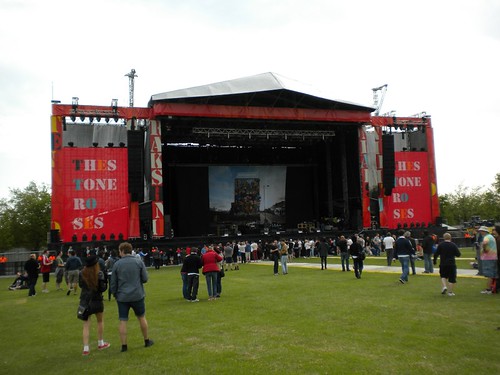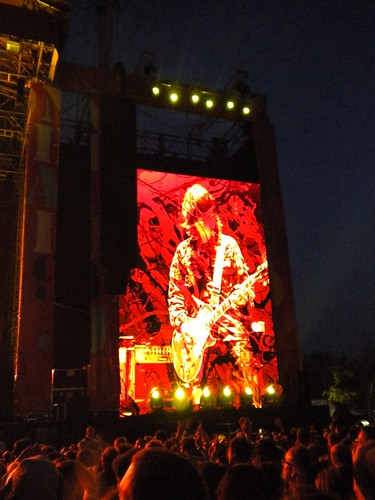Fit to Rule is a series about the British monarchs from early modern times through to Edward VII presented by Lucy Worsley who is looking at the kings & queens through the lens of their medical history. This first episode covered the Tudors & the early Stuarts, getting us from Henry VIII to Charles I.
She started with the familiar story of Henry VIII’s desperation for an heir, and how this lead him to go through several wives and change the religion of the country to get what he wanted. But she also talked about how the health of the King was inextricably linked with the health of the country in people’s minds. Henry was scrutinised at all times by a whole collection of physicians, in particular she mentioned that his urine would be examined for changes & signs of his health. And she talked about how the lack of an heir must’ve taken its toll on his psyche – he is said to’ve cried when Edward was born, and Worsley presented this as tears of relief that the stress was over. But she didn’t mention any of the other health issues around the King, for instance the leg wound he got in a tourney that never quite healed or the (much later) idea that he might’ve had syphilis (I think that’s now discredited but surely still worth a mention?).
Next up is Edward VI, who inherited the throne when he was only 9 – Worsley told us the story of how his procession through London on the eve of his coronation was halted when he wanted to watch the acrobats. He didn’t stay childish for long though. Three years later in his diary he notes the ways in which he thinks his uncle (who is acting as his Protector during his minority) is abusing his power and working against Edward’s interests. And a little later there’s a diary entry stating rather coldly that his uncle was executed. There wasn’t really much about medical matters in this segment, just the fever he catches at the age of 15 and dies from.
Worsley name checked Lady Jane Grey before moving on to Mary. Lady Jane Grey was queen for 9 days because Edward felt she was a more acceptable (Protestant) heir than his Catholic elder half-sister Mary. Mary wasn’t willing to let this stand, and was the only person in this era to successfully revolt and take the crown – she was after all the real next in line to the throne. Worsley told us how Mary was the first ruling queen of England (the Empress Mathilda presumably doesn’t quite count), and was crowned as both King and Queen with two sceptres. Her marriage to Prince Philip of Spain was intended to secure the succession of a Catholic heir, and had to be fenced around with special considerations to overcome the “normal” roles of wife & husband. Philip was firmly in the place of consort not King, and should Mary pre-decease him he would not become King – her heir (hopefully her child) would become the monarch.
Mary was in her late 30s so time was running out for her to have a child, but she showed signs of pregnancy soon after her marriage. At the time protocol required a pregnant Queen to retreat to her chambers & see no-one but her ladies & midwives. This was awkward in the case of a ruling Queen as it removed Mary from the day-to-day politics of the court. Worsley & the expert she was talking to agreed that Mary must’ve shown physical signs of pregnancy because there are so many eye-witnesses that agree. Her physicians (men) couldn’t examine her directly but could take reports from the midwives and look at her external appearance, and they agreed she was pregnant. The Queen also reported feeling the child move. But as the due date came & went, no baby was born. Worsley discussed the possible reasons – a phantom pregnancy (i.e. all in her head), a false conception (i.e. some misshapen mass of flesh that wasn’t a real foetus) or possibly cancer which is what killed her a few years later.
Elizabeth I is next, but the programme pretty much skipped past her – she didn’t have interesting ailments. Neither did James VI & I, her successor, but his more or less open homosexual affairs later in life affected the politics of the realm so we dwelt on him for a while. He also was the first monarch for sometime to come to the throne already in possession of an heir and a spare. His heir, Henry, was the epitome of a Prince – charismatic, handsome, virtuous. Unfortunately at the age of 18 he died of a fever devastating his family, in particular his father. James VI & I’s favourites became more prominent after this, in particular George Villiers (later Lord Buckingham). Diarmaid MacCulloch was the expert Worsley talked to for this segment and he was telling us how having male favourites destabilised the court in a way that a King having mistresses didn’t. Women weren’t regarded as important, so were more easily ignored. But men were potentially political rivals so couldn’t be ignored by the court in general and the closeness of Buckingham (in particular) to the King was resented. Early in his reign James VI & I was an accomplished statesman, but after Henry’s death his infatuation with Buckingham lead to poorer judgement.
And last monarch of this episode was James’s son. Charles I was originally the “spare” and as a solemn, shy child this may’ve lead to his feeling less important and to feel he needed to prove himself. He was also not a very healthy child, Worsley showed us boots that were probably his as a young child. They have particularly reinforced heels & ankles, and she said that his would be to help him stand & walk – he’s known to have had rickets. When he was made Duke of York as a child there were worries he might not manage to stand through the ceremony, so two courtiers were positioned one either side to catch him if he fell. Worsley tied his childhood need to prove himself, and to cover up his weaknesses, to his later conviction he was a divinely appointed monarch who didn’t need Parliament interfering with his governance of the realm. Of course this was to have fatal consequences in the Civil War, ending with his execution. Worsley also showed us one of the two shirts Charles wore as he walked out to be executed – he put two on so that no-one would see him shiver in the January and think him afraid … still trying to hide any weaknesses right to the bitter end.
The second episode of TOWN with Nicholas Crane was about Saffron Walden – a town in Essex near the border with Cambridgeshire. I’ve never been to it, but when I worked in Cambridge the year before I did my PhD at least one of my colleagues lived there.
Saffron Walden is an older town than Oban (the subject of the first episode), dating from Saxon times. Back then it was just called Walden & wasn’t all that big. After the Norman Conquest the de Mandeville family built a castle next to the town & moved the market there from a nearby town. The town was then renamed Chipping Walden (Chipping means it is where the market is, which I didn’t know before). The town was fortified at that time, and despite expansion remained within the lines of its fortifications until the 19th Century (I think that’s what Crane said). It since expanded considerably with more expansion on the cards. The town was also the centre of a saffron crocus farming area, hence the modern name. These days the market for home grown saffron is small, because it’s cheaper to import it from overseas, but Crane talked to a man who is starting to farm it in the area again as a speciality product.
Coming up to the present day there’s a lot of surviving medieval housing & other architecture in the town, and Crane spent some time talking to a plasterer who does pargeting designs on new buildings. When we were watching this bit J & I commented that this looked like the decoration on Ancient House in Ipswich – and I was amused when I looked up pargeting in wikipedia to find that one of the two examples pictured is Ancient House. Crane also visited nearby Audley End house, the seat of the Lords Braybrooke, which is now run by English Heritage and open to the public. He spoke to the oldest daughter of the current Lord Braybrooke who sadly won’t inherit because she’s female (and so are all her siblings – there was no mention who would inherit).
While the market still exists it’s no longer the primary focus of the town – nowadays it’s a commuter town, the train journey to London from Audley Station takes under an hour and the M11 is also conveniently close. Crane visited the newsagents at the station, which is also an off-licence. As well as normal sorts of wines it also sells much more expensive wine – between £100 & £500 per bottle. The chap who runs the shop said he sells 2 or 3 of these per week to people popping in on their way home from work. Which gives you a flavour of the sorts of people who commute from there, I guess!
There were also some spectacular displays of NIMBYism from the townsfolk that Crane spoke to. There’s a development being planned of a reasonably significant amount of housing on the outskirts of the town, and consensus appeared to be that the residents didn’t want it to happen at all. Several of them mentioned it as “affordable housing” and I couldn’t help but feel that part of the objection was that they felt they lived somewhere posh and now there might be riffraff moving in. I’m being a bit unfair here, people did also bring up the problems there would be on the roads given that the proposed development is on the opposite side of town to the railway station. But even so, I think that just means some thought should be put into planning how the road network will cope. The population of the country is growing whether people approve of that or not, and those people need to live somewhere.
Isaac Newton: The Last Magician was a biography of Isaac Newton partly told by interviews with a selection of historians, and partly by dramatised interviews with Newton & contemporaries (using the words of letters by & about Newton). Oh, and some dramatised stuff by John Maynard Keynes, who wrote a biography of Newton back in the 1940s based on papers of Newton’s that Keynes bought at auction in the 1930s. The dramatised bits were a bit hammed up, but that kept them entertaining rather than over-earnest.
Newton starts life in inauspicious circumstances in 1642. He was been a small & premature baby and wasn’t expected to live long. His father dies when he is very young, and his mother abandons him to be brought up by his grandparents when she re-marries when he is 3. He did well at school, not so well with other people (in the sins he listed in code he included things like threatening to burn down the house with his mother & her husband in it), and started on some of the obsessions that would stick with him for the rest of his life. For instance he turned the attic into a giant sundial – marking out how the light changed in the room with time.
At the age of 17 his mother pulled him out of school to come & run the farm now her husband had died. He did sufficiently badly at that that he was sent off to Cambridge to study instead (which also reinforced his sense that he had a destiny to study & to work out how the world functioned). He studied natural philosophy, what would now be called science. He then began to experiment and investigate time, light, optics and many more subjects for himself. It’s during this period that he did some of the things he’s remembered for – he did the experiments with the prisms showing that white light can be split into colours but these coloured lights cannot be further split. He did the experiments on optics that could’ve blinded him – looking at the sun in a mirror to see how it affected his vision, inserting a bodkin under his eyeball to see what effect deforming the eye had on vision. He also invented calculus (but didn’t tell anyone about it). The programme made no mention of Leibniz, I guess so as not to complicate the story.
Eventually his peers at Cambridge brought him to the attention of the Royal Society & Newton started to share his work & thoughts. He published a paper on his work on splitting light into colours, but this was reviewed by Hooke who pronounced it not of much worth. Newton flounced off in a huff, and took his toys with him. He did no more scientific work for the next 12 years – and until Maynard Keynes bought up some of his papers in the 1930s it wasn’t known what he had been doing. He was engaged in alchemical experiments – trying to find the Philosopher’s Stone which would transmute things into gold. And trying to figure out what made things alive (I think this fits into this bit). During this time he also developed his theological ideas into a sufficiently extreme form as to count as heresy. He did not believe in the Trinity, in particular insisting that Christ was a man and not the Son of God.
Newton returned to non-occult science via a correspondence with Halley about the orbits of the planets. Inspired partly by the idea that his enemy, Hooke, couldn’t figure it out Newton set to working out why the planets orbit how they do – leading to his theory of gravity, and his laws of motion. His publication of these ideas (as the Principia Mathematica) was well received, except by Hooke who tried to claim that he’d thought of it all first. The two men had an undignified spat, but Newton won out this time.
Newton had a nervous breakdown in 1693, the causes of which are unclear. The various talking heads on the programme suggested reasons ranging from him having recently worked with large quantities of mercury to the breakdown of a particularly close friendship with a Swiss mathematician immediately before. After his nervous breakdown they were saying that he never really did any more work – he refined some ideas, but that was it for novel ideas.
In later life he became more of a politician – he was made Warden of the Royal Mint, and was also the President of the Royal Society. He remained arrogant and poor at dealing with people, however. In a letter to the Royal Astronomer he orders the man about demanding that he provide data that Newton wants. This rather predictably puts the man’s back up as he regarded himself as a peer of Newton, not a servant.
After Newton died he was buried in Westminster Abbey, in with the Kings & Queens, despite his extreme Protestantism (the extent of his heresy wasn’t really known at that time). His reputation afterwards was as the first rationalist, the start of the Enlightenment. The experts on the programme were saying that to keep this reputation intact any papers of Newton’s that referred to alchemy or religion were kind of shuffled under the carpet – locked up in a box until sold off at auction in the 1930s.
An interesting & informative programme – the dramatisation of the bits from the letters really brought them to life. And it showed how much more there was to Newton than the myth.
















